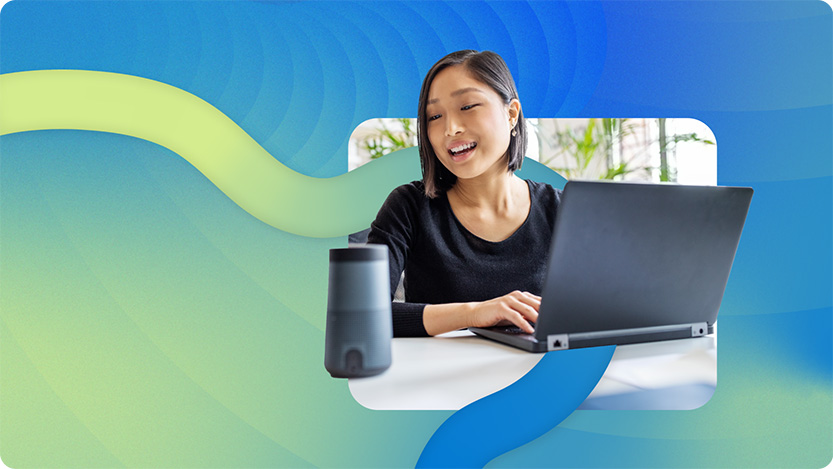Blog post
Boost Your Conversion Rate by 52%: The Desktop Performance Report

Increasingly, consumers are browsing, shopping, and playing on mobile devices. While mobile may have higher overall usage, accounting for 59.3% of global web traffic compared to 40.7% on desktop, reach is only part of the story.
Desktop reflects a different mindset: focus, depth, and readiness to act. As conversational AI reshapes discovery and decision-making—and holiday campaigns ramp up in anticipation of the busiest shopping moments of the year—desktop provides a stable and intent-rich environment, remaining an essential stage in your search advertising strategy.
Shoppers are on desktop for the biggest holiday decisions, whether comparing options, confirming policies, or completing purchases. Consider desktop a seasonal performance lever, not an afterthought, because the brands that prepare now will be best positioned when high-intent traffic spikes.
Where audiences are motivated to act
People often shift to desktop for a larger screen, greater control, and the freedom to evaluate more details at once. This is especially true when a task carries weight, like comparing financial products, completing complex workflows, or planning a major purchase.
Microsoft Advertising data reinforces this pattern:
- Conversion rates on desktop are 52% higher than mobile.1
- People are 25% more likely to use a PC, laptop, or tablet over a mobile device when addressing important tasks.1
- People are 19% more likely to click on an ad and 20% more likely to add an item to their cart on desktop compared to mobile.2
These moments of clarity and confidence are where people lean in and take action. Meanwhile, the Microsoft desktop audience is both sizable and valuable. Windows reaches over 1 billion customers with users spending 4 hours per day on Windows devices.2
Within this audience:2
- 49% have made a purchase in the past week.
- 29% are decision-makers.
- 57% spend six to 10 hours per day online.
This combination of scale, quality, and intent makes desktop a natural home for Copilot-powered experiences that drive conversion.
Copilot and desktop are better together
Desktop is emerging as one of the most powerful surfaces for Copilot engagement, as generative AI transforms how people search and shop. Individuals can scan more information, explore multiple links, and move toward action thanks to bigger screens, fewer distractions, and a stable environment. Desktop is ideal for AI-assisted research and decision-making, especially in B2B, finance, travel, and high-consideration retail.
Seasonality further underscores this behavior. Between November 2024 and February 2025, 86% of traffic from generative AI sources originated from desktops, according to Adobe Analytics. Whether making a significant purchase, gifting during peak holiday retail windows, or navigating complex product research, people rely on desktop for concentration and completion.
Recent Microsoft data confirms how desktop strengthens Copilot adoption and engagement:
- New PC entry points are driving scale as a leading way people access Copilot, proving that AI assistants are not “mobile only.”3
- 38% of users who navigated to Copilot from Bing on PC later increased their Bing usage.3
- 3 in 4 people (74%) say Copilot complements traditional search, showing that it enhances, rather than replaces, existing discovery habits.3
Copilot's integration across Windows, Edge, and Bing is evolving desktop into a hub for AI-powered, decision-ready experiences. Desktop users expect more control, richer context, and deeper content than on mobile. Winning creative taps into this mindset with assets designed to build confidence and drive action, including:
- Product specs and clear comparisons
- Detailed demos and policies
- Customer testimonials and expanded benefit messaging
Desktop placements also support greater detail, like carousels in Microsoft Ads, so marketers can use a modular approach, flexing assets across formats without reinventing their core creative vision.
Tip: Use our Audience Planner to model desktop-heavy holiday personas, estimate monthly reach, and get bid/budget guidance. Then, build Audience ads directly from your plan (including location, demographics, company/industry, job function, and more).
How marketers can reprioritize desktop today
Desktop isn’t a legacy device: it’s a critical performance channel where customer decision journeys that started on mobile often finish at a PC. Neglecting desktop means missing bottom-funnel moments where decisions are made, and Microsoft environments consistently show stronger ROI for these decisive interactions.
Reprioritize desktop in practice by:
- Checking your performance mix. Audit conversion data to identify how desktop supports late-stage, high-intent decisions. Segment reporting by surface to see where ROI is highest: desktop or mobile?
- Designing with a cross-device experience in mind. Ensure messaging aligns across surfaces while recognizing desktop’s role in research and final actions.
- Using richer content formats. Leverage formats that take advantage of larger screens, such as comparison tables, long-form storytelling, and demos. Test and refine delivery using Microsoft tools like Performance Max, Multimedia ads, and Audience ads.
- Plan for seasonality. During peak retail windows, big-ticket purchases frequently shift back to desktop, so align budgets and creative accordingly.
Activate your strategic advantage, just in time for the holidays
Desktop remains a decisive stage in today’s AI-powered journey, but many marketers are underestimating it. Discover how to align your creative and targeting across desktop, mobile, and emerging AI surfaces in our recent guide, The new search advertising landscape: How to win when AI is changing everything.
And with holiday shopping on the horizon, explore our newest guide, The advertiser’s holiday performance playbook, to capture seasonal intent across devices and maximize results during peak retail moments.
[1] Activision Blizzard Media Simultaneous Media Usage Study via Toluna, Oct–Nov 2024 (Base: US Adults 18+), GWI, 2025; Microsoft internal data, 2022.
[2] GWI Core, Q1 2023-Q1 2024, Global; Comscore, US Data, June 2024; Microsoft internal data, 2024
[3] Microsoft First Party Data | Oct 2024 – Feb 2025; US Gen Pop consumers who have experience with a conversational search platform | July/ August 2024; n=1005.
Your input makes us better
Take our quick 3-minute survey and help us transform your website experience.




